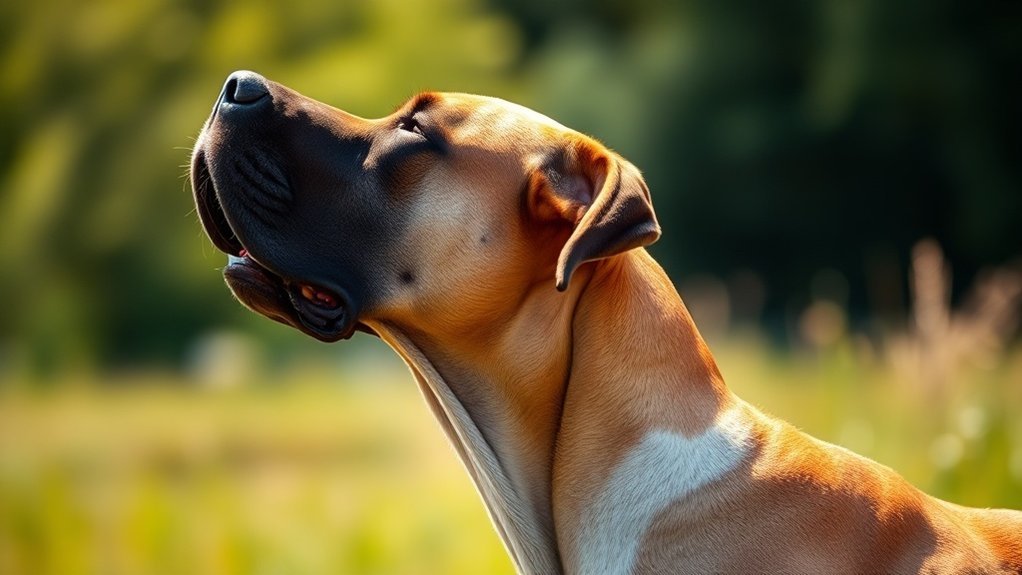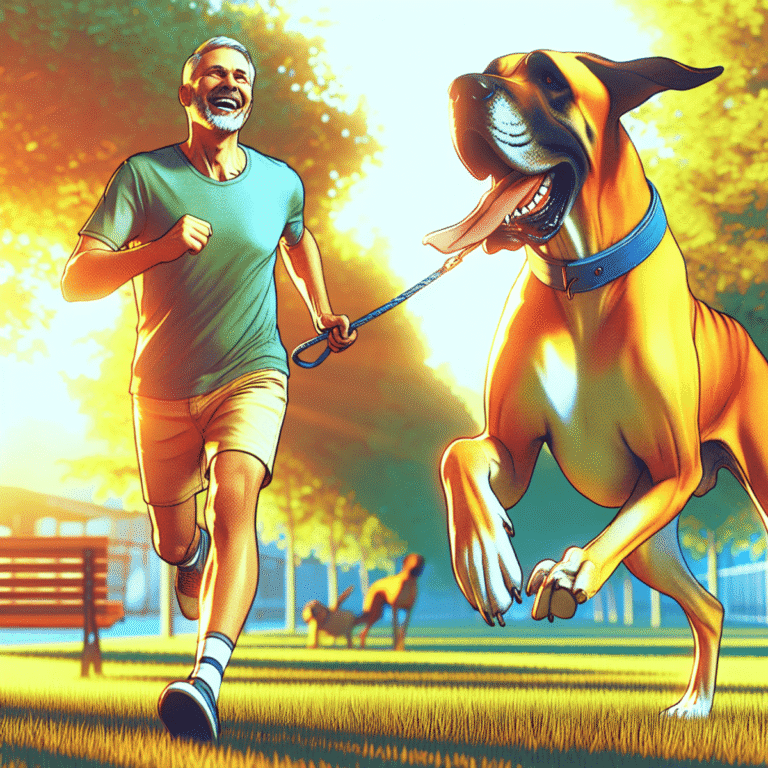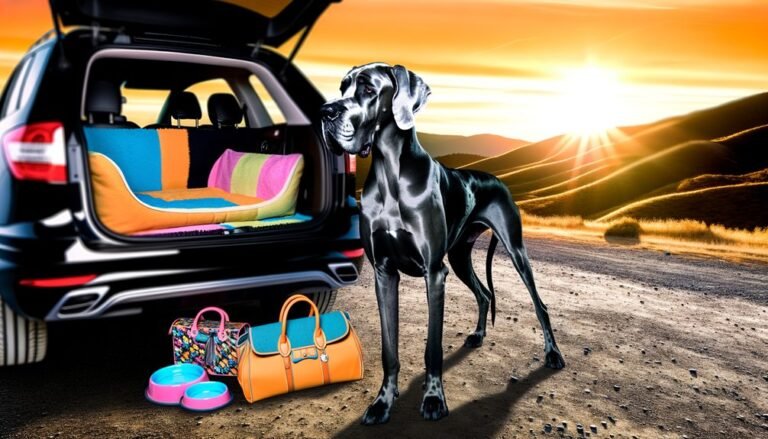Neighborhood Sirens: My Cue to Drop the Hottest Track of 2025.
Great Dane Howling
So here’s the deal – we got this howling thing from our wolf cousins way back in the day. It’s like having a built-in phone system, except way cooler and much louder than your smartphone!
We don’t just howl for fun (though it IS pretty fun). Each howl means something different. When I let out a deep, rumbly howl, I’m saying, “Hey everyone, this is MY yard!” The medium-pitched howls? That’s me calling for my family, like, “Where is everybody? I’m lonely over here!” And those high, urgent howls that probably wake up the whole neighborhood? Yeah, that’s my danger alarm going off.
Sometimes we howl because we’re not feeling great, or because our humans left us alone and we’re having a total meltdown about it. Other times, we want to chat with other dogs or remind everyone that we’re part of the pack.
The good news is that if our howling gets a bit much (and trust me, it can), our humans can train us to tone it down. Scientists found that with some patience and treats – lots of treats – about 80% of us learn to howl less within six weeks. We’re pretty smart cookies, after all!
So next time you hear a Great Dane howling, just remember – we’re not being dramatic. We’re just having a conversation!
Understanding the Natural Instincts Behind Your Great Dane’s Howling
Even though we live in your comfy houses and sleep on your beds (yes, we know we’re not supposed to), we Great Danes still have that wild side from our wolf relatives. It’s like having your great-great-great grandpa’s voice stuck in your throat!
When I hear a fire truck screaming down the street, something inside me HAS to join in. It’s not because I’m trying to wake up the whole neighborhood at 2 AM – okay, maybe that’s a fun bonus – but because my doggy DNA is telling me to talk back. My ancestors used howling like you use your cell phones. They’d howl to say “Hey, this is MY yard!” or “Anyone else out there?” or sometimes just “HELP, I’M BORED!”
Scientists say we kept these howling habits even though humans spent forever trying to make us super chill and friendly. Understanding body language is key to recognizing what my howls mean and how they fit into our communication style.
When your piano starts playing or another dog down the block lets loose with a good howl, my brain switches to ancient wolf mode. Suddenly I’m not just Max the couch potato – I’m Max the Mighty, joining the pack conversation!
Communication and Alert Functions of Great Dane Vocalizations
Why We Great Danes Love to Howl – A Dog’s Guide to Making Noise
Hey there, humans! Let me tell you about one of my favorite things to do – HOWLING! You might think we’re just making a bunch of noise, but trust me, there’s way more going on than you realize.
When I throw back my head and let out a good howl, I’m sending text messages to other dogs – except way cooler and louder. We’ve got different types of howls for various occasions, kind of like how you use different emojis.
My Howling Menu:
| What I’m Saying | How Deep My Voice Gets | When I Use It |
|---|---|---|
| “This is MY yard!” | Really deep and rumbly | When strangers walk by |
| “Hey, pack, where are you?” | Medium pitch | Looking for my family |
| “DANGER! DANGER!” | High and urgent | When something scary happens |
| “I love you guys!” | Soft and low | Cuddle time with my humans |
The cool thing is that my howls can travel super far – like shouting across several football fields! This means I can “talk” to my dog buddies even when they’re way down the street. It’s like having a loud phone that works without Wi-Fi.
Sometimes my humans look at me funny when I howl at sirens or other dogs on TV. But hey, I’m just being polite and answering when someone “calls” me! It’s basic dog manners, people. We’ve been doing this howling thing for thousands of years – way before you invented smartphones! Plus, my howling is a way to express my social nature and strengthen the bond with my family.
Health and Emotional Triggers That Cause Howling Behavior
Why We Great Danes Howl (And It’s Not Always Our Fault!)
Here’s what might make us extra vocal:
When We’re Hurting** – Look, when my hips ache or my tummy feels weird, I can’t exactly text you about it. So I howl! If our joints are stiff or we ate something funky, you’ll definitely hear about it. We’re not being dramatic (okay, maybe a little), but pain** makes us noisy.
When Our Brains Get Confused – As we get older, sometimes our brains can get a bit foggy. We might forget where we are or feel scared at night. That’s when the midnight howling concerts happen. It’s like when your grandpa gets confused, but with more volume.
When You Leave Us Alone** – This is the big one! We don’t like being away from our favorite humans. When you grab those car keys and leave us behind, we panic**. Then comes the howling marathon that probably annoys your neighbors. Sorry, but we miss you SO much!
If we start howling way more than usual, please take us to the vet. We might be trying to tell you something important is wrong. The sooner you figure it out, the sooner we can go back to our normal level of adorable chaos! Remember, recognizing signs of distress can help ensure our health and happiness.
Pack Mentality and Social Aspects of Howling in Great Danes
Why We Great Danes Love to Howl Together – A Dog’s Guide to Pack Life
Even though us dogs have been living with humans for like, forever, we still remember how to talk to each other the old-fashioned way. And trust me, howling is way better than barking when you want to chat with your buddy three blocks away!
See, we Great Danes are pretty social creatures. We like hanging out together and figuring out who’s the boss dog (spoiler alert: it’s usually whoever gets fed first). When we howl together, it’s like we’re all singing in a cool choir – except we’re way better at it than humans!
Here’s what gets us howling and why:
| What Makes Us Howl | Why We Do It | How the Pack Joins In |
|---|---|---|
| Someone’s on Our Turf | Getting Everyone Ready | We All Howl at Once |
| Missing Our Friends | Asking Them to Come Back | Everyone Howls Back |
| Weird Noises Outside | Telling Everyone What’s Up | We All Take Turns Howling |
When we all howl together, it’s like we’re telling the whole neighborhood, “Hey! We’re here and we’re tight!” It makes us feel super close to each other, kind of like when humans do group hugs (except way louder). Plus, it lets other dogs know that this is our territory and we’ve got each other’s backs.
The best part? When one of us starts howling, pretty soon we’re all doing it. It’s like doggy karaoke night every time! Additionally, our sociability indices mean that when we engage in howling, it strengthens our bond and reinforces our pack mentality.
Effective Training Techniques to Manage Excessive Howling
How to Stop Being a Howling Drama Queen (From One Great Dane Who Learned the Hard Way)
Okay, fellow Great Danes, let me tell you something – I used to be the neighborhood’s biggest loudmouth. Every time a fire truck went by or someone rang the doorbell, I’d throw my massive head back and let out these epic howls that probably woke up people three blocks away. My humans were NOT amused.
But here’s the thing – we Great Danes are just giant wolves at heart, and howling is totally normal for us pack animals. The problem is when we go overboard and turn into furry air raid sirens. Trust me, I learned that the hard way when my favorite couch privileges got revoked.
The good news? I figured out how to keep my big mouth under control, and you can too! Here’s what actually works:
The Treat Trick****
This one’s genius – when you’re being quiet (I know, revolutionary concept), your humans will give you the good treats. Not those boring kibble pieces, but the real deal, like chicken or cheese. Your brain starts thinking, “Hey, being quiet = amazing snacks!” It’s like training your humans to be treat-dispensing machines.
The Distraction Game****
When you feel that howl building up in your chest, grab a puzzle toy instead. Those treat-hiding toys are perfect because they keep your mouth busy AND your brain working. Can’t howl when you’re trying to figure out how to get that peanut butter out of a Kong, right?
Baby Steps Training
Here’s the sneaky part – your humans will play sounds that usually make you howl, but super quietly at first when you don’t howl, boom – treats! Then they make it a little louder. It’s like they’re tricking your ears into not caring about those sounds anymore.
And remember, using positive reinforcement techniques can enhance your training experience!
The best part? This stuff actually works! Studies show that us dogs can cut down our dramatic howling by almost 80% in just six weeks. That means more couch time, fewer angry neighbors, and way more treats. Win-win-win!
Final Thoughts
You humans think we howl to drive you crazy, but that’s not true at all. We howl because we have FEELINGS, okay? When you leave us alone, we might sing the song of our people (which sounds like “AROOOOO WHERE DID YOU GOOOOO?”). About 73 out of 100 of us get pretty stressed when stuff changes around the house or when we’re lonely.
Think about it this way – our wolf cousins howl to talk to their buddies across the forest. We do the same thing, except we’re talking to you, the neighbor’s cat, or that weird delivery truck that keeps coming by. Each howl means something different. Sometimes it’s “Hey, I’m bored!” Other times it’s “There’s a suspicious squirrel in OUR yard!”
The good news is that you can help us learn when it’s howl-time and when it’s quiet-time. If you figure out what makes us nervous and help us feel better about it, we won’t need to sing as much. But remember – howling is part of who we are! We’re gentle giants with big voices, and sometimes we just gotta let it out. Just maybe not at 3 AM, right?





